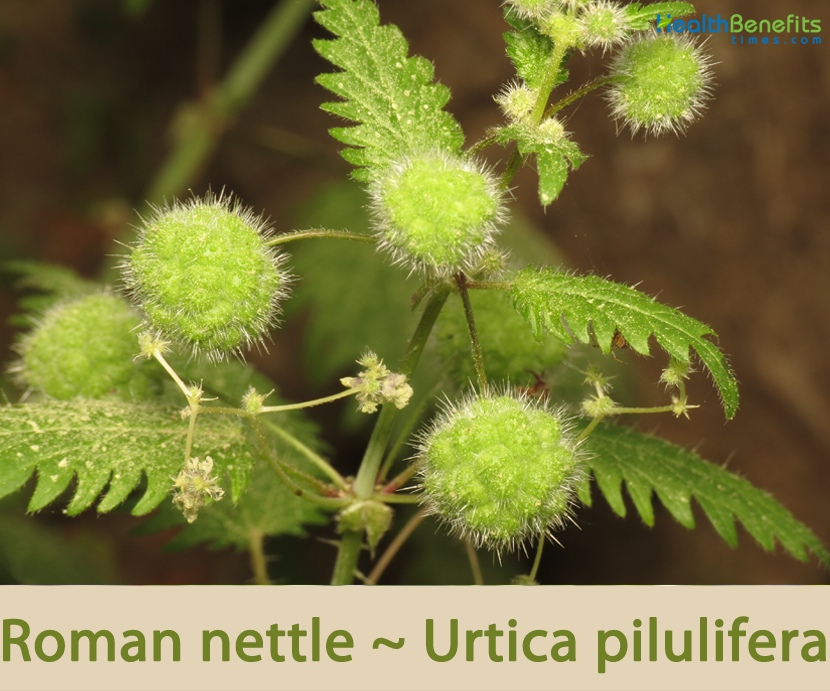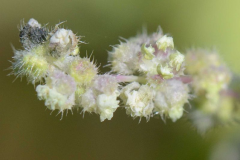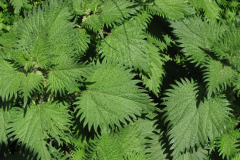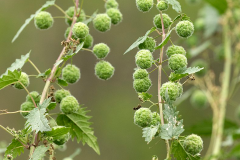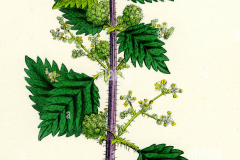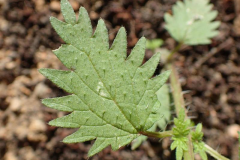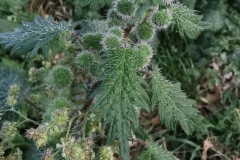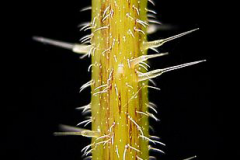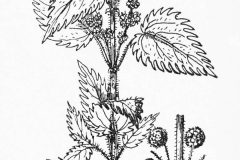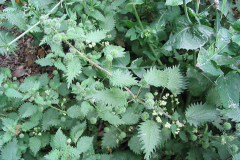| Roman nettle Quick Facts | |
|---|---|
| Name: | Roman nettle |
| Scientific Name: | Urtica pilulifera |
| Origin | Countries around the Mediterranean, and eastwards into the Arabian Peninsula and Iran. |
| Colors | Initially green turning to dark brown as they mature |
| Shapes | Broadly ovate achene about 2.5 mm long and 2 mm broad |
| Health benefits | Support for internal bleeding, anemia, excessive menstruation, hemorrhoids, arthritis, rheumatism, skin complaints, especially eczema, gout, sciatica, neuralgia, hair problems, postoperative blood loss and bacteriuria |
| Name | Roman nettle |
|---|---|
| Scientific Name | Urtica pilulifera |
| Native | Countries around the Mediterranean, and eastwards into the Arabian Peninsula and Iran. It has been introduced into Belgium, Germany and Great Britain. It is no longer found in Britain |
| Common Names | Roman nettle |
| Name in Other Languages | Albanian: Hithri, hither Aragonese: Ixordiga, ortiga Arabic: Angurah, Nabât en nâr, Qurrays, zighlil (zaghlyl) (زغليل (زَغْليل)), zirbih (zurbyh) (زربيح (زُربيح)), shaer aleajuz ( shaer aleajuza) (شعر العجوز ( شَعر العجوز), eaqar kabir (عقار كبير) Bulgarian: Sferichna kopriva (сферична коприва) Catalan: Ortiga balera Czech: Kopřiva Dodartova, Kopřiva kulkonosná Danish: Romersk nælde Dutch: Kleine brandnetel, Kogelbrandnetel English: Roman nettle Estonian: Rooma nõges Finnish: Pallonokkonen French: Ortie à pilules, Ortie romaine German: Pillen-Brennessel, Pillennessel, römische Nessel Greek: Megáli tsouknída (μεγάλη τσουκνίδα), oúrtika sfairidiofóros (ούρτικα σφαιριδιοφόρος), tsouknída (τσουκνίδα) Hebrew: Sirpad hakkaddurim, srpd hkdurim (סִרְפַּד הַכַּדּוּרִים) Hungarian: Római csalán, Szedercsalán Italian: Ortica romana, Ortica a campanelli Norwegian: Romersk nesle Persian: گزنه توپی Polish: Pokrzywa pigułkowata, Pokrzywa kuleczkowata Romanian: Urzica mica Russian: Krapiva sharikonosnaya (крапива шариконосная) Slovak: Pŕhľava guľkonosná, žihľava guľkonosná, žihľava kulkonosná Spanish: Ortiga de pelotillas, ortiga macho, ortiga pildorera, ortiga romana, Ortiga balera Swedish: Romersk nässla Turkish: Isırğan out, Dalağan Ukrainian: Kropyva hustokvitkova (Кропива кулястоквіткова), kropyva kulʹkonosna (кропива кульконосна) Upper Sorbian: Pilowa kopřiwa Welsh: Danhadlen Belaidd |
| Plant Growth Habit | Herbaceous annual flowering plant |
| Growing Climates | Cultivated land, field, waste places, path and road sides, disturbed zones, Mediterranean Woodlands, shrub lands, semi-steppe shrub lands, shrub-steppes, deserts, extreme deserts preferring light soils |
| Soil | Nutrient-rich soils |
| Plant Size | Around 2 feet tall |
| Stem | Square red stems full of an irritant liquid |
| Leaf | Leaves with 2-10 cm long petiole; lamina is ovate to broadly ovate, 2-10 cm long and 2-8 cm broad, truncate or sub-cordate – cordate at the base, margin shallow to deeply serrate and apex acuminate |
| Flowering season | June to September |
| Flower | Roman Nettle is not dioecious, or even bisexual, but is monoecious, with separate male and female flowers on the same plant. The female flowers are on stalks growing from the leaf axils and are globular consisting of many female flowers each and are green to red |
| Fruit Shape & Size | Broadly ovate achene about 2.5 mm long and 2 mm broad |
| Fruit Color | Initially green turning to dark brown as they mature |
| Propagation | By seed |
| Season | July to October |
Leaves
Leaves with 2-10 cm long petiole; lamina is ovate to broadly ovate, 2-10 cm long and 2-8 cm broad, truncate or sub-cordate – cordate at the base, margin shallow to deeply serrate and apex acuminate. Stipules are free lateral, triangular-ovate to lanceolate, 3-6 mm long and membranous. Leaves consist of stinging hairs, which can irritate the skin.
| Leaf presence and metamorphosis | Leaves present, not modified |
| Leaf arrangement (phyllotaxis) | Opposite |
| Leaf shape | Simple – entire |
| Stipules | Present |
| Petiole | Present |
| Leaf life span | Summer green |
| Leaf anatomy | Mesomorphic |
Flower
Unlike Stinging Nettle, Roman Nettle is not dioecious, or even bisexual, but is monoecious, with separate male and female flowers on the same plant. The female flowers are on stalks growing from the leaf axils and are globular consisting of many female flowers each and are green to red. The white halo around the spheres is yet more stinging trichomes. The male flowers are much smaller with 4 white petals and in bunch along the stalks which also emerge from the leaf axils. Flowering normally takes place in between June to September.
| Flowering period [month] | June–September |
| Flower color | Green |
| Perianth type | Reduced |
| Perianth fusion | Reduced |
| Inflorescence type | Fasciculus |
| Dicliny | Monoecious |
| Pollination syndrome | Wind-pollination |
Fruits
Fertile flowers are followed by broadly ovate achene about 2.5 mm long and 2 mm broad. They are initially green turning to dark brown as they mature. They are enclosed by enlarged dorsal sepals.
| Fruit type | Dry fruit – achene/cypsela/samara |
| Fruit color | Black |
| Reproduction type | Only by seed/spores |
| Myrmecochory | Non-myrmecochorous |
Traditional uses and benefits of Roman Nettle
- Roman nettle have a long history of use in the home as an herbal remedy.
- Tea made from the leaves has traditionally been used as a tonic and blood purifier.
- Whole plant is anti-asthmatic, antidandruff, astringent, depurative, diuretic, galactogogue, hemostatic, hypoglycemic and a stimulating tonic.
- An infusion of the plant is very valuable in stemming internal bleeding.
- It is also used to treat anemia, excessive menstruation, hemorrhoids, and arthritis, rheumatism and skin complaints, especially eczema.
- Externally, the plant is used to treat arthritic pain, gout, sciatica, neuralgia, hemorrhoids, hair problems etc.
- For medicinal purposes, the plant is best harvested in May or June as it is coming into flower and dried for later use.
- This species merits further study for possible uses against kidney and urinary system ailments.
- Juice of the Roman nettle can be used as an antidote to stings from the leaves.
- An infusion of the fresh leaves is healing and soothing as a lotion for burns.
- Homeopathic remedy is made from the fresh plant, gathered when in flower.
- It is a useful first-aid remedy used in the treatment of ailments such as bites and stings, burns, hives and breast feeding problems.
- The plant extract used in ointment as agent for skin regeneration.
- It is widely used in folk remedy to treat hyperglycemia, hypertension and inflammation of some organs such as uvula and uterus, uterus bleeding, anemia, wound healing, as purifier and as toner tea.
- It is used for various immune disorder and applied either topically or taken orally as an herbal tea.
- Herb extract is useful for bladder disorder, it reduced postoperative blood loss, bacteriuria, and prevented hemorrhagic and purulent inflammation following adenomectomy.
Culinary Uses
- Young leaves can be cooked and used as a potherb.
- It is a very nutritious food, high in vitamins and minerals; it makes an excellent spinach substitute and can also be added to soups and stews.
- Only use the young leaves and wear stout gloves when harvesting them to prevent getting stung.
- Although the fresh leaves have stinging hairs, thoroughly drying or cooking them destroys these hairs.
- Nettle beer is brewed from the young shoots.
Other Facts
- A strong flax-like fiber is obtained from the stems.
- It is used for string and cloth; it also makes a good quality paper.
- It is collected as the plant begins to die down in early autumn.
- Growing plant increases the essential oil content of other nearby plants, thus making them more resistant to insect pests.
- Hair wash is made from the infused leaves and this is used as a tonic and antidandruff treatment.
- Green dye is obtained from the leaves and stems.
- Yellow dye is obtained from the root.
- Oil extracted from the seeds is used as an illuminant in lamps.
- It is a casual plant (now thought not to exist in the UK).
Precautions
- Leaves of the plants have stinging hairs, causing irritation to the skin.
- This action is neutralized by heat so the cooked leaves are perfectly safe and nutritious.
- However, only young leaves should be used because older leaves develop gritty particles called cystoliths which act as an irritant to the kidneys.
- It may cause allergic reactions or irritation in contact with the skin or mucous membranes.
- Roman nettle although less toxic, is still a dangerous plant.
- The hairs that cover the roman nettle are like tiny needles.
- They cause burning, itching and swelling of the skin and redness in the affected area.
- The irritation usually passes soon, around 1 to 3 hours, but if hairs remain embedded in the skin the irritation can last a day or more.
- Some people may be allergic to roman nettle and should seek medical attention.
- If pets such as cats and dogs are accidentally punctured by roman nettle bristles, they may experience burning, itching and swelling of the skin and redness in the affected area as humans.
References:
https://www.inaturalist.org/taxa/348964-Urtica-pilulifera
https://pfaf.org/user/Plant.aspx?LatinName=Urtica+pilulifera
https://gd.eppo.int/taxon/URTPI
https://en.wikipedia.org/wiki/Urtica_pilulifera


